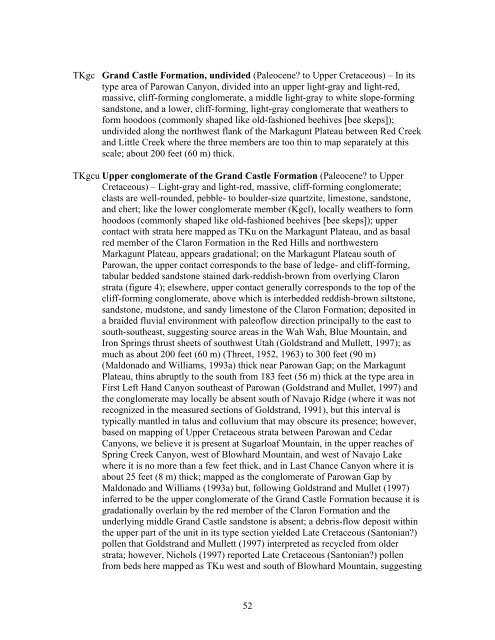Interim Geologic Map of the West Part of - Utah Geological Survey
Interim Geologic Map of the West Part of - Utah Geological Survey
Interim Geologic Map of the West Part of - Utah Geological Survey
You also want an ePaper? Increase the reach of your titles
YUMPU automatically turns print PDFs into web optimized ePapers that Google loves.
TKgc Grand Castle Formation, undivided (Paleocene? to Upper Cretaceous) – In itstype area <strong>of</strong> Parowan Canyon, divided into an upper light-gray and light-red,massive, cliff-forming conglomerate, a middle light-gray to white slope-formingsandstone, and a lower, cliff-forming, light-gray conglomerate that wea<strong>the</strong>rs t<strong>of</strong>orm hoodoos (commonly shaped like old-fashioned beehives [bee skeps]);undivided along <strong>the</strong> northwest flank <strong>of</strong> <strong>the</strong> Markagunt Plateau between Red Creekand Little Creek where <strong>the</strong> three members are too thin to map separately at thisscale; about 200 feet (60 m) thick.TKgcu Upper conglomerate <strong>of</strong> <strong>the</strong> Grand Castle Formation (Paleocene? to UpperCretaceous) – Light-gray and light-red, massive, cliff-forming conglomerate;clasts are well-rounded, pebble- to boulder-size quartzite, limestone, sandstone,and chert; like <strong>the</strong> lower conglomerate member (Kgcl), locally wea<strong>the</strong>rs to formhoodoos (commonly shaped like old-fashioned beehives [bee skeps]); uppercontact with strata here mapped as TKu on <strong>the</strong> Markagunt Plateau, and as basalred member <strong>of</strong> <strong>the</strong> Claron Formation in <strong>the</strong> Red Hills and northwesternMarkagunt Plateau, appears gradational; on <strong>the</strong> Markagunt Plateau south <strong>of</strong>Parowan, <strong>the</strong> upper contact corresponds to <strong>the</strong> base <strong>of</strong> ledge- and cliff-forming,tabular bedded sandstone stained dark-reddish-brown from overlying Claronstrata (figure 4); elsewhere, upper contact generally corresponds to <strong>the</strong> top <strong>of</strong> <strong>the</strong>cliff-forming conglomerate, above which is interbedded reddish-brown siltstone,sandstone, mudstone, and sandy limestone <strong>of</strong> <strong>the</strong> Claron Formation; deposited ina braided fluvial environment with pale<strong>of</strong>low direction principally to <strong>the</strong> east tosouth-sou<strong>the</strong>ast, suggesting source areas in <strong>the</strong> Wah Wah, Blue Mountain, andIron Springs thrust sheets <strong>of</strong> southwest <strong>Utah</strong> (Goldstrand and Mullett, 1997); asmuch as about 200 feet (60 m) (Threet, 1952, 1963) to 300 feet (90 m)(Maldonado and Williams, 1993a) thick near Parowan Gap; on <strong>the</strong> MarkaguntPlateau, thins abruptly to <strong>the</strong> south from 183 feet (56 m) thick at <strong>the</strong> type area inFirst Left Hand Canyon sou<strong>the</strong>ast <strong>of</strong> Parowan (Goldstrand and Mullet, 1997) and<strong>the</strong> conglomerate may locally be absent south <strong>of</strong> Navajo Ridge (where it was notrecognized in <strong>the</strong> measured sections <strong>of</strong> Goldstrand, 1991), but this interval istypically mantled in talus and colluvium that may obscure its presence; however,based on mapping <strong>of</strong> Upper Cretaceous strata between Parowan and CedarCanyons, we believe it is present at Sugarloaf Mountain, in <strong>the</strong> upper reaches <strong>of</strong>Spring Creek Canyon, west <strong>of</strong> Blowhard Mountain, and west <strong>of</strong> Navajo Lakewhere it is no more than a few feet thick, and in Last Chance Canyon where it isabout 25 feet (8 m) thick; mapped as <strong>the</strong> conglomerate <strong>of</strong> Parowan Gap byMaldonado and Williams (1993a) but, following Goldstrand and Mullet (1997)inferred to be <strong>the</strong> upper conglomerate <strong>of</strong> <strong>the</strong> Grand Castle Formation because it isgradationally overlain by <strong>the</strong> red member <strong>of</strong> <strong>the</strong> Claron Formation and <strong>the</strong>underlying middle Grand Castle sandstone is absent; a debris-flow deposit within<strong>the</strong> upper part <strong>of</strong> <strong>the</strong> unit in its type section yielded Late Cretaceous (Santonian?)pollen that Goldstrand and Mullett (1997) interpreted as recycled from olderstrata; however, Nichols (1997) reported Late Cretaceous (Santonian?) pollenfrom beds here mapped as TKu west and south <strong>of</strong> Blowhard Mountain, suggesting52
















